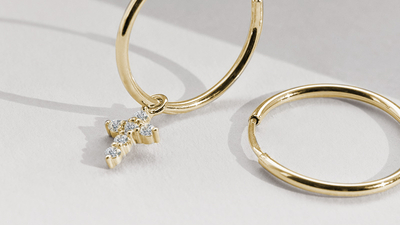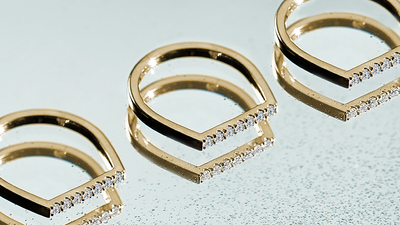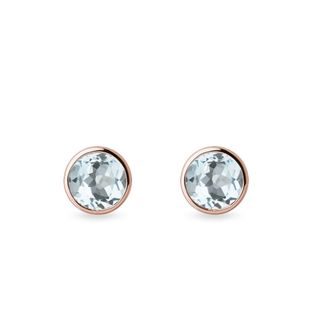Looking at an aquamarine is like looking into the clearest sea. The origin of this gemstone's name therefore doesn’t surprise: it was created by combining the words aqua and marina, meaning sea water. Since ancient times, the stone has been used as a protective amulet for sailors who roam the unpredictable waters of the oceans and seas. The aquamarine has watched over them to bring them safely to land.
Aquamarine’s history, traditions and legends
Aquamarines have been known to people since ancient times. During the Roman Empire, this gemstone was connected with relationships, especially with the endurance of love. This is also one of the reasons why it was customary to give an aquamarine to a woman as one of the first gifts after she was married. The stone was also known to the Egyptians and the Sumerians. In their cultures, aquamarine was a symbol of happiness and eternal youth. In Europe, from the 14th century onwards, it was used as a grindstone for making lenses and spectacles.
Aquamarines belong to the month of October. They are also associated with the moon and the element of water. It was said to be the stone of ancient sea goddesses. It represents peace and quiet and it helps the wearer to calm their mind, overcome stress and to take responsibility for one's own life. It brings harmony to relationships and it is a strong stone of courage.
 |
 |
Aquamarines suit Geminis, Aquarians Pisceans or Leos. Aquamarine jewelry is traditionally given as a gift on a 19th wedding anniversary. You could for instance, select a combination of earrings and a necklace. And a ring with an aquamarine is suitable, for example, for the birth of a son while aquamarine engagement rings have also become more and more popular recently.
Aquamarine from a scientific point of view: its properties
Aquamarines, along with emeralds and morganites belong to the family of beryls. Chemically speaking, aquamarine is classified as beryllium aluminosilicate (Be3Al2Si6O18). Usually it is blue or blue-green in color, very rarely also light yellow. The blue color is caused by the presence of iron but it can also contain titanium. Aquamarines often display dichroism. They can break down light, so at different angles they vary the intensity of their color.
Aquamarines are translucent to transparent. On the hardness scale, they are just after the quartz, with values of between 7.5 to 8. They are relatively brittle, they do not have perfect cleavage, they fracture in a conchoidal manner and their luster is vitreous. They crystallize in a hexagonal system. The crystals are prismatic, in rare instances up to 11.8 inches long. Aquamarines are typically found in cavities, granite pegmatites or in alluvial (river) gravel deposits. They are dissolved by hydrofluoric acid.

How to choose the most beautiful aquamarine
The delicate pale blue color typical of aquamarines is very fashionable these days. In the 19th century, people preferred blue-green shades. Today however, stones with greenish hues are valued less than blue pieces. And as with other gemstones, the richer the color, the higher the price. Aquamarines can have various shades of blue. From pale to azure to deep blue. In jewelry making, it is the pale blue stones which are used most often due to their relatively favorable price. The lower quality and opaque aquamarines are used to make statues and coral beads or are cut into cabochons. These can also sometimes display the cat's eye effect.
Aquamarine’s light color and relatively high degree of transparency means that any imperfections, inclusions or cracks in it are clearly visible. Fortunately, the stone isn’t too prone to these and it is rare to find a flawed piece. This is in spite of the fact that due to the large size of the crystals, aquamarines can be cut into relatively large gemstones. This feature of aquamarines has another huge advantage. Because natural aquamarines which are considered to be perfect are not so scarce and the cost of producing aquamarines in a laboratory is high, there is no need to worry about buying a fake piece. Its price would probably exceed the price of a natural stone.
 |
 |
In order for the stone to sufficiently show off its blue, it has been stated that the stone should be over 5 carats in size (at least 1 gram). But there are exceptions. In some regions of the world, aquamarines with a deeper color are mined. These show a beautiful blue color even at sizes of less than 5 carats. For this reason, we may encounter smaller stones that are more expensive than larger stones of the same color.
Cuts and colors that suit aquamarines
Aquamarines are most often cut in the shape of ovals or in the emerald cut (which has the shape of a rectangle with bevelled edges). However, in the KLENOTA range, you’ll also find several other shapes. For example, you could choose a piece of jewelry with a round aquamarine. Stud earrings with stones in the trillion cut are original and modern as are simple teardrop-shaped pendants. And a heart-shaped gemstone is perfect for something more romantic.
Aquamarines perfectly complement diamonds of any size and shape and they suit all three basic colors of gold: white, yellow and rose.

How to care for aquamarines and what to look out for
Aquamarines are transparent to translucent stones, so everything is visible through them. Occasionally, customers bring us their aquamarine rings which have lost their luster and which have changed color. Such stones are usually coated in a layer of dirt. They just need to be gently cleaned and the aquamarine will shine like before. We therefore recommend that to prevent contamination, you remove rings with aquamarines especially before cooking and cleaning. An aquamarine may fade over time in the sun. Therefore, keep it in a closed box, away from light and dust.
Like with many other stones, the color of aquamarines undergoes adjustment. They are heated to temperatures of 750 - 840°F to remove unwanted yellow and greenish shades. Sometimes they are also treated by irradiation, which increases their color saturation. Of course, those aquamarines that have not undergone any color adjustment processes are more valuable. Every merchant should give you complete information about the stone you are interested in. When buying KLENOTA jewelry, you will receive a certificate of authenticity free of charge as a matter of course.
 |
 |
Interesting facts and records
Globally, significant aquamarine deposits are found in the USA (Colorado), Brazil, Russia, India, Pakistan, Sri Lanka, Madagascar, Zimbabwe, Kenya and South Africa. However, the rarest and most color saturated aquamarines are mainly mined in Brazil, Madagascar or Nigeria.
The largest known aquamarine was found in Brazil near the town of Marambaia in 1910. It weighed 17.3 stone, was almost 1.6 feet long and 1.2 feet wide. It is called the Minas Gerais. Today, a part of it is in the Smithsonian Institute in Washington, DC. Another record holder is also at the Smithsonian - the blue-green Dom Pedro aquamarine. It has been cut into the shape of an obelisk. In its raw state, it weighed 7 stone and measured almost 3.3 feet.
But other famous aquamarines have also come from Brazil. Such as the aquamarine collection of Queen Elizabeth II, which she received from the President of Brazil in 1953, on the day of her coronation. Another famous aquamarine became the symbol of Brazilian-American friendship. This green-blue gem originally weighed 2.8 pounds, but it was cut into two pieces. The larger one was cut and faceted and given as a gift to Eleanor Roosevelt, wife of the US president.






















